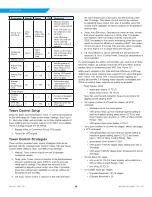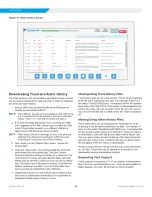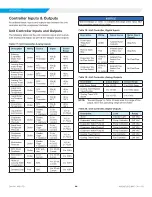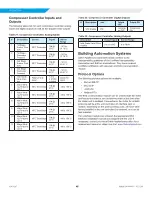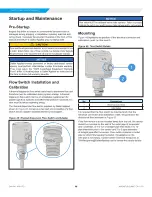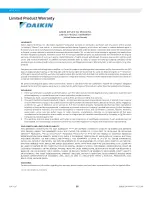
STARTUP AND MAINTENANCE
MAGNITUDE WMT CHILLER
DAIKIN APPLIED
50
roughly 10 o’clock and 2 o’clock.
•
Loosen the remaining two bolts to enable the head
to be separated from the tube sheet sufficiently for a
clevis pin or hook to be inserted into an open bolt hole
at the top of the head.
•
Attach a hoist to the pin or hook, lift the head to
remove weight from the two remaining bolts, remove
the bolts, and carefully remove the head.
•
Do not try to install a machine thread eyebolt into the
head vent fitting, which has pipe threads.
•
Reverse this procedure to mount the head, using a
new gasket.
3 .
Condenser Flow Sensor: The condenser sensor should
be cleaned anytime the condenser is opened. This should
typically be performed at the annual inspection; however,
more frequent cleaning may be required depending on
the conditions of the jobsite. Recommended maintenance
includes the following:
•
Check the sensor tip for buildup.
•
Clean the tip using a soft cloth. Stubborn buildup,
such as lime, can be removed using a common
vinegar cleaning agent.
4 .
Electrical Panels: Excessive accumulation of dirt within
panels can damage components, inhibit good air
circulation, and make visual inspections difficult.
Water Treatment
Special care must be taken when utilizing open system water that
is usually not treated (such as lakes, rivers, and ponds). The use
of untreated water will result in corrosion, erosion, slime buildup,
scaling, or algae formation. Water treatment service must be
used. Special tube and water head material may be required to
reduce damage from corrosion. Daikin Applied is not responsible
for damage or faulty operation from untreated or improperly
treated water. See
for caution
statement on water quality.
Seasonal Shutdown
WARNING
The condenser and evaporator are not self-draining. Where the
chiller can be subject to freezing temperatures, the condenser
and evaporator must be drained of all water. Water permitted
to remain in the piping and vessels can rupture these parts if
subjected to freezing temperatures. Dry air blown through the
vessels will aid in forcing all water out.
Except for freezing conditions, it is desirable to leave water in the
vessels to avoid long term exposure to air.
Continuous forced circulation of antifreeze through the
vessels is one method of avoiding freeze up .
Seasonal Startup
Seasonal startup procedures are as follows:
1 .
Leak test the unit.
2 .
Check and tighten all electrical connections.
3 .
Replace the drain plugs (including cooling tower pump and
tower drain) if they were removed at shutdown the previous
season.
Maintenance Schedule
Table 35
provides an overview of recommended maintenance
procedures along with how frequently these procedures should
be performed.
Table 25: Recommended Maintenance Schedule
Monthly
Quarterly
Semi-Annually
Annually
As Required By
Performance
During Season
-
al Shutdown
During Season
-
al Startup
I . Compressor
Analyze Compressor
Fault Log
X
Check IGV operation
X
Check and tighten
compressor electrical
connections
X
An inspection should
be performed on the
compressor
*X
II . MicroTech Controls
Check for proper
settings
X
Verify transducers and
sensors for accuracy
X
Retrieve and archive
HMI Trend Logs
O
Perform MicroTech
check, log, and last fault
analysis
X
III . Condenser
Confirm correct water
flow and pressure drop
O
X
Confirm appropriate
water treatment
O
Clean and Leak Test
condenser tubes
X
X
X
Eddy Current Test - tube
wall thickness
X
Seasonal Protection
X
Clean Flow Sensor
X
X
IV . Evaporator
Confirm correct water
flow and pressure drop
O
X
Confirm appropriate
water treatment
O

